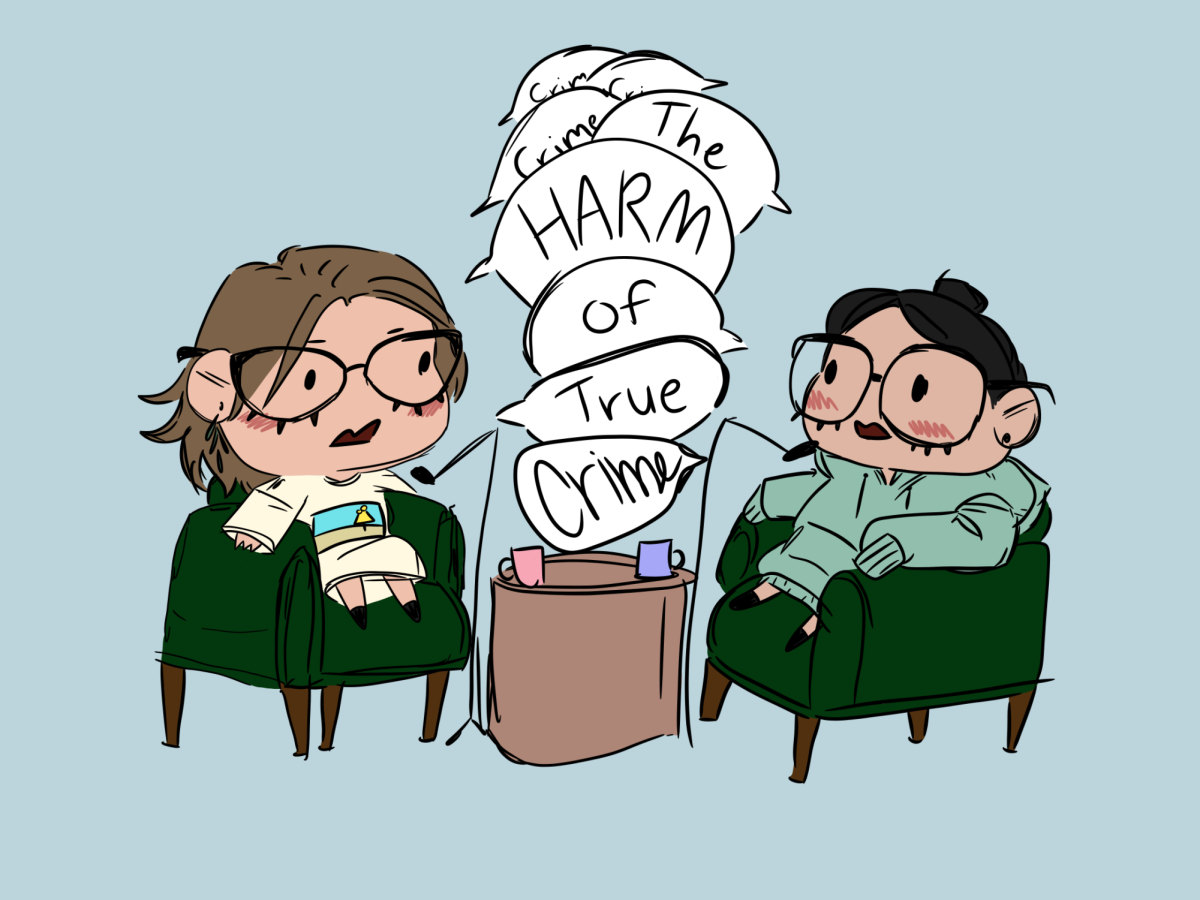Her last meal was nearly 36 hours ago. Her stomach grumbles, but she doesn’t notice. She throws another sweatshirt on and begins to run, wishing it was warmer so she’d sweat faster. She hasn’t consumed so much as a sip of water all day. Instead, she spits what moisture that remains in her mouth into an empty water bottle.
She stands. Shivers. Then steps on the scale.
This might be a girl with an eating disorder.
According to the National Institute of Mental Health (NIMH), approximately 2.7 percent of 13 to 17-year-olds suffer from an eating disorder. Girls are almost three times more likely to be diagnosed.
According to NIMH “although males with eating disorders exhibit the same signs and symptoms as females, they are less likely to be diagnosed with what is often considered a female disorder.”
WebMD describes the term “eating disorder” as a condition that causes a person to have “unhealthy thoughts and behaviors related to food and body image.”
“Some people with eating disorders severely restrict their food intake, while others eat excessively,” WebMD explains. “They may also vomit, take laxatives or exercisew excessively to try to prevent weight gain.”
His last meal was nearly 36 hours ago. His stomach grumbles, but he doesn’t notice. He throws another sweatshirt on and begins to run, wishing it was warmer so he’d sweat faster. He hasn’t consumed so much as a sip of water all day. Instead, he spits what moisture that remains in his mouth into an empty water bottle.
He stands. Shivers. Then steps on the scale.
This might be an Albert Lea High School wrestler.
Male athletes show a higher rate of eating disorders than the general male population. For example, in weight-class and aesthetic sports like wrestling, bodybuilding and gymnastics, 33 percent of males are affected by eating disorders (National Eating Disorder Association), while experts estimate that only 10-15 percent of the general male population are affected.
To defend against these disorders, NEDA encourages coaches and parents to “be aware of and disallow any excessive weight control or body building measures employed by their young male athletes.”
The Minnesota State High School League attempts to prevent these behaviors in wrestling by requiring a Minimum Weight Permit Form. This form, completed at the start of the season, establishes a minimum wrestling weight based on body fat. A trained skin-fold technician uses calipers to measure the thickness of the skin in the tricep, infra scapular, and abdominal. These measurements are used to calculate the wrestler’s weight at 7 percent body fat–the minimum weight class he will be allowed to wrestle in. This information is recorded and the form is signed by the skin-fold technician, the coach, the student and his parent.
“The purpose of this report is to prevent undue and unsafe weight reduction for competitive purposes—weight reduction which might jeopardize the physical, scholastic and psychological well-being of the student,” the form states. “During the wrestling season, which can extend to early March, the student-athlete should eat and drink normally while in training and participating in wrestling activities.”
Head Coach Larry Goodnature takes over from there.
“It’s my job as a coach to make sure that I train my athletes to get the maximum out of them so they stay fit and they stay healthy,” Goodnature said.
High school wrestling weight classes range from 106 to 285 pounds, their purpose being to ensure fairness. Only wrestlers in similar weight classes compete against each other; the idea is that no one wrestler will have a decided advantage over the other only because of weight.
When asked about the least favorite thing associated with their sport, a common answer among wrestlers is cutting weight. Why do wrestlers cut weight?
“So we can wrestle smaller kids,” explained senior Trevor Westerlund.
Westerlund said during the off-season, he usually weighs around 132 pounds. He’s been wrestling in the 113-pound weight class. Westerlund said most of his teammates wrestle at the lowest weight they’re permitted to as specified by the Minimum Weight form.
“I don’t even consider it ‘cutting weight,’” Goodnature said. “You work out, you do everything right, and you lose body fat.”
To wrestle in a certain weight class, a wrestler must not weigh more than the number associated with that class. However, a two-pound growth allowance goes into effect after Jan. 1, so athletes wanting to wrestle in the 113-pound class may weigh a maximum of 115 pounds.
“Everyone else cuts weight,” said senior Dakota Wangsness. “So if I stay at what I actually weigh then I’d wrestle bigger kids.”
And with the intensity of wrestling practices, some of the off-season weight disappears through workouts.
“Once practice starts, everyone loses, like, five pounds right away,” Wangsness said. “Because that’s how hard practice is.”
Varsity wrestlers typically practice at least 14 hours per week, with practices after school 4 days a week and morning practices on Mondays and Wednesdays.
Coach Goodnature likens wrestling practices to popular workout programs such as Insanity and P90X.
“I teach technique, I teach nutrition. I teach cardiovascular fitness,” Goodnature explained. “My workouts are designed to keep the body fit.”
Goodnature said the purpose of morning workouts is to “speed up [the] metabolism in the mornings to burn off calories.”
“When you do all these workouts and you watch your diet–your caloric intake–everything else takes care of itself,” he said.
Wrestlers weigh-in on Thursdays and Fridays to show that they’ve maintained their weight.
Weigh-ins are also conducted a few hours prior to every match to ensure that each wrestler weighs no more than what he is allowed to in order to wrestle in his designated class.
“Right now I can’t eat because I have to make weight after school,” said sophomore varsity wrestler Beau Johnsrud, before a home match Feb. 8 against John Marshall. “I usually weigh 112 but I have to make 108. So it’s just four pounds.”
Just four pounds. That may not seem like much, but sometimes wrestlers lose those four pounds in a few days. Mayo Clinic recommends a loss of one to two pounds per week.
According to Weight Watchers “losing weight at a rate greater than an average of two pounds per week increases your risk of developing health problems like heart beat irregularities, anemia, excessive loss of lean body mass (muscle), bowel irregularities and gallstone formation.”
If he doesn’t make weight, he doesn’t wrestle. When weigh-ins are completed, it’s back to the locker room to fuel up on food before the match starts.
“After weigh-ins I can eat as much as I want,” Westerlund said with a laugh.





![At the pepfest on Feb. 13 the Winterfest Royalty nominees were introduced. There were two girls and two boys candidates from each grade. Royalty included Prince Axel Calderon (11), Jacob Miller (12), Princess Maya Fuller (11), Brecken Wacholz (10), Ethan Brownlee (9), Lord Given Saw (9), Lilly Elmer (9), Angela Buansombat (10), Queen Jenna Balfe (12), Hanna Austinson (11), Raegan Broskoff (8), Duchess Evalyn Holcomb (10), Jordyn Earl (8), and Lady Leighton Brenegan (9). Not pictured include: King Kaiden Baldwin-Rutherford (12), Piper Aanes (12), Blair Blake (11), Duke Kuol Duol (10), Thoo Kah (8) and Aidric Calderon (8). Student council member and Junior Prince Axel Calderon said, “It [the nomination] means that I’m kind of a student leader. I hopefully show younger kids what it means to be a part of the student council and lead the school.”](https://www.ahlahasa.com/wp-content/uploads/2025/03/front-page-1200x800.jpeg)















